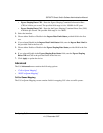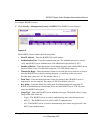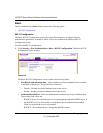
GS700TP Smart Switch Software Administration Manual
6-4 Managing Security
v1.0, December 2007
• Active – Select the priority in which the system performs authentication with a Radius
Server. The system performs authentication initially with the Radius Primary Server, and
if it fails, it performs authentication with the Radius Backup Server. The possible values
are:
– Primary – Defines the RADIUS Primary Server.
– Backup – Defines the RADIUS Backup Server.
2. Select the RADIUS server entry.
3. Enter the Host IP Address, Authentication Port, Number of Retries, Timeout for Reply,
Dead Time and Key String in the provided fields in the first row.
4. Select the Usage Type and Active server from the lists in the provided fields in the first row.
5. Click Apply to update the device.
To add a new RADIUS server entry:
1. Click Security > Management Security > RADIUS. The RADIUS screen displays.
2. Enter the Host IP Address, Authentication Port, Number of Retries, Timeout for Reply,
Dead Time and Key String in the provided fields in the first row.
3. Select the Usage Type and Active server from the lists in the provided fields in the first row.
4. Click Add to update the device.
To remove a RADIUS server entry:
1. Click Security > Management Security > RADIUS. The RADIUS screen displays.
2. Select the RADIUS server entry.
3. Click Delete to remove the entry.
TACACS+
Terminal Access Controller Access Control System (TACACS+) provides centralized security
user access validation. The system supports up-to 2 TACACS+ servers.
TACACS+ provides a centralized user management system, while still retaining consistency with
RADIUS and other authentication processes.
The TACACS+ protocol ensures network integrity through encrypted protocol exchanges between
the client and TACACS+ server. The TACACS+ default parameters are user-assigned defaults.
The default settings are applied to newly defined TACACS+ servers.


















